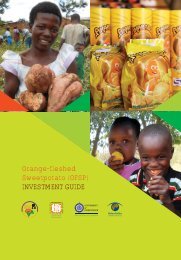Recommendation
Up89Y
Up89Y
You also want an ePaper? Increase the reach of your titles
YUMPU automatically turns print PDFs into web optimized ePapers that Google loves.
equests from national advocates and regional champions, RAC produced and<br />
published three investment guide products with PowerPoint presentations to<br />
inform and guide investors, implementers and policy‐makers. The guides were<br />
closely aligned to the CAADP process, which was in sync with the RAC regional<br />
advocacy strategy and the prevailing development agenda for Sub‐Saharan Africa.<br />
Analysis: RAC succeeded in raising investment in OFSP from local government<br />
leaders because the simple investment guides directed them on what to invest in<br />
and how much to invest, based on the needs of their communities. Indeed,<br />
government, donor, private sector and philanthropic investors are more likely to<br />
allocate resources to projects where carefully targeted investment guides help<br />
them visualize what and where to invest, what it takes to turn ideas into<br />
programmes and projects, and the returns on OFSP investment.<br />
<strong>Recommendation</strong>: When designing projects like RAC that advocate for increased<br />
investment in the value chain, the development of investment guides should be<br />
planned for from the onset. Such guides allow governments, donors and the<br />
private sector to make evidence‐based decisions on where and how to spend their<br />
money.<br />
Lesson learned: An investment guide is a critical tool in advocating for increased<br />
investment in OFSP. Clear guidance on how to transform ideas into programmes<br />
and projects leads to better and more effective programming. Consequently, such<br />
investment decision‐support tools help to spur investment in biofortified crops to<br />
combat vitamin A deficiency.<br />
Capacity building lesson 1 – equipping high level advocates<br />
Background: The RAC project design did not provide details on scaling up of OFSP.<br />
The advocacy team employed several strategies at national and regional levels and<br />
worked with advocates and champions from civil society organizations and the<br />
private and public sectors at varying levels of seniority. RAC advocates and<br />
champions needed to be sensitized on the importance of promoting and investing<br />
in OFSP. They also needed skills to advocate for policy change and investment at<br />
the macro level.<br />
Experience/challenge: RAC’s experience was that although NGOs carried out<br />
advocacy work, most of them tended to focus on capacity building at the<br />
operational level. Often, their project designs focused on implementation at the<br />
farmers’ level and ignored the broader political economy that is so crucial for<br />
upscaling. Understandably, these advocates faced challenges when engaging in<br />
high level policy processes. Similarly, in instances where relatively junior national<br />
19



